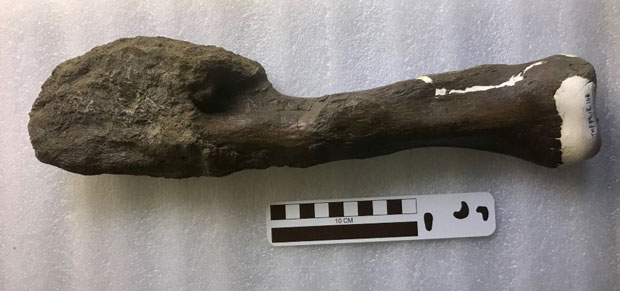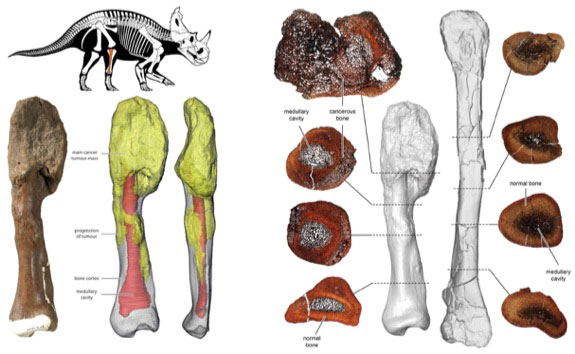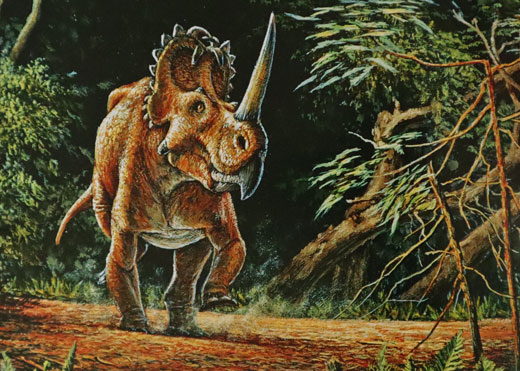Rare Malignant Cancer Diagnosed in Centrosaurus Bone
Bone Cancer (Osteosarcoma) Identified in Dinosaur Fibula
Scientists have identified a rare malignant cancer in the fossilised bone of a horned dinosaur. Writing in “The Lancet Oncology”, the researchers report on the discovery and diagnosis of an osteosarcoma in the lower leg bone (fibula), of a Centrosaurus (Centrosaurus apertus). This is the first time that an osteosarcoma has been found in the fossilised bones of a dinosaur.
An Osteosarcoma Identified in the Leg Bone of a Dinosaur (Centrosaurus apertus)
Picture credit: Royal Ontario Museum
What is an Osteosarcoma?
Osteosarcoma is a cancer that produces immature bone. There are an estimated 3.4 million cases reported in the human population each year. It mostly occurs in young people, under the age of 25 and there is some evidence to suggest that it is more prevalent in males. In our species, osteosarcoma is associated with periods of rapid bone growth, to date the cause, genetic alterations, oncogenic events and evolutionary history of osteosarcoma are poorly understood.
The research team included scientists from the Royal Ontario Museum, McMaster University (Ontario) and the Okayama University of Science (Japan), along with numerous other specialists in pathology, molecular medicine, image resonance and oncology. They subjected the leg bone to high-resolution computed tomography (CT) scans. Thin sections were than prepared and examined under a microscope to assess the specimen at the bone-cellular level. The investigators were able to reach a diagnosis of osteosarcoma, the first time such a diagnosis has been identified in a member of the Dinosauria.
Centrosaurus Life Reconstruction
Picture credit: Michael W. Skrepnick
Originally Believed to be a Healing Fracture in the Centrosaurus Bone
The Centrosaurus bone was found in 1989 in the Dinosaur Provincial Park (Alberta). The badly malformed bone was thought to represent a healing fracture but it was decided to investigate its unusual morphology in order to better understand the pathology.
A Cast of the Deformed Bone (Fibula) of Centrosaurus

Picture credit: Danielle Dufault (Royal Ontario Museum)
One of the co-authors of the paper, Rhianne Crowther (Trent University, Ontario), commented:
“Diagnosis of aggressive cancer like this in dinosaurs has been elusive and requires medical expertise and multiple levels of analysis to properly identify. Here, we show the unmistakable signature of advanced bone cancer in 76-million-year-old horned dinosaur — the first of its kind. It’s very exciting.”
Confirming the Diagnosis, Human Compared to a Dinosaur
To confirm the diagnosis of osteosarcoma, the bone was compared to a normal fibula from a Centrosaurus. It was then compared to a human fibula with a confirmed case of osteosarcoma. The Centrosaurus was an adult dinosaur and the cancer was at an advanced stage, suggesting that it probably invaded other organs and parts of its body. The bone comes from an extensive monodominant Centrosaurus bonebed, so this dinosaur probably died with a large number of other animals in its herd during a catastrophic flood.
David Evans, a palaeontologist at the Royal Ontario Museum added:
“The shin bone shows aggressive cancer at an advanced stage. The cancer would have had crippling effects on the individual and made it very vulnerable to the formidable tyrannosaur predators of the time. The fact that this plant-eating dinosaur lived in a large, protective herd may have allowed it to survive longer than it normally would have with such a devastating disease.”
Seper Ekhtiari, an Orthopaedic Surgery Resident at McMaster University, who had also been involved in this study, stated:
“It is both fascinating and inspiring to see a similar multidisciplinary effort that we use in diagnosing and treating osteosarcoma in our patients leading to the first diagnosis of osteosarcoma in a dinosaur. This discovery reminds us of the common biological links throughout the animal kingdom and reinforces the theory that osteosarcoma tends to affect bones when and where they are growing most rapidly.”
It is hoped that this research will establish a new standard for the diagnosis of unclear pathology in vertebrate fossils. Forging links between pathology preserved in fossilised bones and human medicine will help scientists to gain a better understanding of the evolution and genetics of various diseases.
Everything Dinosaur acknowledges the assistance of a media release from the Royal Ontario Museum in the compilation of this article.
The scientific paper: “First case of osteosarcoma in a dinosaur: a multimodal diagnosis” by Seper Ekhtiari, Kentaro Chiba, Snezana Popovic, Rhianne Crowther, Gregory Wohl, Andy Kin On Wong, Darren H Tanke, Danielle M Dufault, Olivia D Geen, Naveen Parasu, Mark A Crowther and David C Evans published in The Lancet Oncology.
The Everything Dinosaur website: Everything Dinosaur.



